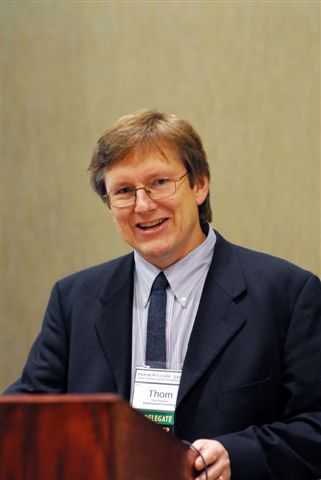 This is the second in a series of guest posts by @IM4Ward, on behalf of the PS Engage planning committee.
This is the second in a series of guest posts by @IM4Ward, on behalf of the PS Engage planning committee.
The PSEngage conference is happening November 22, 2011 and the line-up of speakers is inspiring. To give more insight to the knowledge and interests of the speakers we sent them each a set of questions tailored to their individual experience. We will be posting the questions and their responses over the next few weeks, so please keep checking back regularly.
 Today’s interview is with @Thumbtackhead, John Weigelt, National Technology Officer at Microsoft Canada.
Today’s interview is with @Thumbtackhead, John Weigelt, National Technology Officer at Microsoft Canada.
John’s participation at PS Engage 2011 will be to share examples of government 2.0 activities across jurisdictions. If you’ve read John’s bio and his blog,http://www.thumbtackhead.ca/, you’ll realize quite quickly that John has an interesting approach to innovation. Innovation for John is not a wishy-washy process, but rather something that requires rigour and structure to bring out, explore and ultimately exploit creative ideas to achieve the objectives. Perhaps this comes from John’s military training. Read the questions and answers below to come to your own conclusions.
Q1: Your biographic information says you went to military college – Do you think military training influenced your approach to innovation? If so, how?
A1: I think that my military training influenced my approach to innovation in several ways. The best way to consider this is to try to imagine the crosswalks between a military operation and a business process. For both it is critically important that leaders select and maintain the objective. By describing their objectives leaders can empower entire communities to innovate to help attain the broader goal. Military training also helps people think about broad and often innovative approaches to solving a complex challenge. When encountering a tough adversary, a military leader will consider a wide variety of factors, probabilities and build out several scenarios to test an idea. Rarely will the effective leader choose a single approach to victory. Full campaigns will include a main action, perhaps several auxiliary actions, feints, special forces etc. All must be performed with creativity and innovation, lest the adversary gain the upper hand by being able to predict what may happen. With innovation, it’s important to look broadly across the problem space to seek out new approaches. Finally, one last thing that it helped me appreciate is the concept of Exercising Empowerment. Sometimes people in very structured organizations like the military, government or large businesses project a sense that there is little room for independent thinking. I would suggest that it is actually the opposite and that great ideas are always welcomed. Not that I would encourage everyone in uniform to pick their own pace when on parade, but there are opportunities to innovate within all structures.
Q2: Technology is driving a lot of innovation and change – What can business leaders do to understand the innovation options presented by technology without becoming a technologist. What are the types of questions business leaders should be asking?
A2: I think that the business leaders need to consider the outcomes from innovation. The Boston Consulting Group identifies 5 outcomes from innovation:
- New to world products or markets
- Expanding your current customer base
- Reaching entirely new types of customers
- Incremental changes to existing products
- Improving efficiency in existing processes.
By focusing on the outcome, the business leader can abstract out the technology and explore the business outcome that will be driven. Rarely does innovation simply pop arbitrarily into mind, rather, it is usually as a result of hard work on a particular problem carefully extended through a connection with other ideas or experimentation. Business leaders should therefore focus on their area of expertise and look to harness adjacent innovation by extending their expertise through the careful application of technology.
Q3: In your blog post, “Hearsay and other crimes against innovation” you emphasize the importance of fact checking and conducting the necessary research to substantiate the proposal. Can you give some ideas or examples of how these elements can be built into a business case?
A3: Evidence based decision making is fundamental to managing the risks and opportunities presented by any change to the status quo. To make good decisions, it is essential that there be a thorough understanding of the evidence being used. There are any number of ways that statistics can be presented in a biased manner (as is well described in “how to lie with statistics” .In one case I saw an internet study where a very small percentage of a small global sample size answered (with a checkbox) that they had lost between $10 and $100 due to a particular type of fraud. The study went on with some gratuitous extrapolation by multiplying the $100 Maximum against the entire Canadian population to arrive upon a multi-billion dollar impact for this fraud. This created an alarming number, 4X any number previously proposed. Given the margins for error, the factor of 10 difference in the potential losses all multiplied 1000s of times created a completely fictional statistic that eventually made headlines. Imagine what would happen if the government program leader took that number at face value to look to resolve what was reported as a huge problem. Even worse that the potential loss of funds, the misdirection of resources or efforts due to mis-prioritization has the potential to torpedo not only service delivery programs but sink entire businesses.
Q4: The Fed. Government is pushing improvements in the management of information through policies and directives – resulting in the focus of efforts being on compliance, rather than on opportunity. What can you say about the relationship between information management and opportunity?
A4: Information is the lifeblood of government/ businesses and has been called the cornerstone of democracy. It is therefore paramount that information be properly managed throughout its lifecycle. Policies, directives, standards, guidelines and recommendations all play a role in providing advice and guidance for consistency across the organization. While compliance is a necessary part of business and government routine, I’ve always had a love hate relationship with the term and how some people approach it. In the worst cases, compliance is a sort of lowest hurdle to get over to be able to operate. Like the runner in the Olympic race, some organizations will look to barely clear their compliance requirements, or just hit them so that they don’t get into trouble with their oversight body. It has been shown that even though an organization meets its compliance checklist, it can completely fail in the meeting the objective of the compliance requirement in the first place. I believe that organizations should look broader than simple compliance to fully capitalize on the opportunities that can be garnered by going beyond the checklist.
Be sure to see John and other smart people at PS Engage, November 22, 2011.
 Welcome to #GovChat Central! I’m your host @ThomKearney
Welcome to #GovChat Central! I’m your host @ThomKearney We are rapidly approaching the 1st Anniversary of
We are rapidly approaching the 1st Anniversary of 


